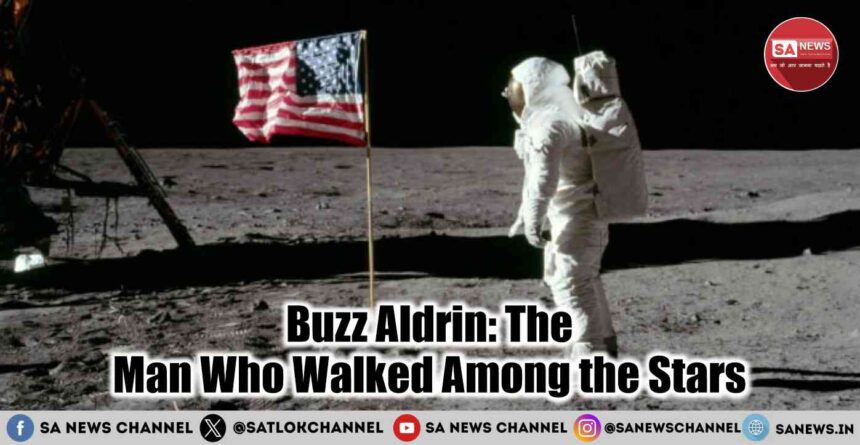What does it take to step on the moon? Courage, intellect, and belief in human potential. Buzz Aldrin embodied all these traits, and he became the second man to step on the moon during the Apollo 11 mission. The first man to step on the moon was Neil Armstrong. Buzz Aldrin was with Neil Armstrong on that same mission. Buzz Aldrin was a symbol of determination and exploration. His journey is more than just a moonwalk. Let’s know more about his life.
- From Fighter Pilot to Space Pioneer: Aldrin’s Early Life
- Aldrin’s Road to NASA: Becoming an Astronaut
- Apollo 11: A Giant Leap for Mankind
- Life After Apollo
- Buzz Aldrin’s Legacy: Buzz Aldrin
- Buzz Aldrin: The Unstoppable Explorer
- The Sky Is Unlimited and Leads the Road to Our Home
- How One Would Go to Satlok
- Connect With Us on the Following Social Media Platforms
From Fighter Pilot to Space Pioneer: Aldrin’s Early Life
Buzz Aldrin: Buzz Aldrin was born on 20th January in Montclair, New Jersey. His original name was Edwin Eugene Aldrin Jr. His father, Edwin Aldrin Sr., was an aviation pioneer who instilled in him a love for flight. Aldrin’s fascination with aviation and space was deeply influenced by his father. His mother’s name was Marion Moon Aldrin. She had the word “Moon” in her maiden name.
Aldrin excelled in academics. He completed his schooling at Montclair High School. He graduated from the U.S. Military Academy at West Point in 1951 with a degree in mechanical engineering. His excellent academic record and military discipline set the base for his future as a pilot and astronaut.
Aldrin got his first name, Buzz, when his brother once mispronounced “brother” as “Buzzer,” and this became his nickname over time. In 1988, he officially and legally changed his name from Edwin to Buzz.
He became a pilot, and his first test of bravery was in the Korean War. There, he flew 66 combat missions as an Air Force pilot. He shot down two enemy MiG-15 jets and won a Distinguished Flying Cross for himself.
Aldrin’s Road to NASA: Becoming an Astronaut
Buzz Aldrin and Gemini 12: After coming back from the battlefield, he pursued a doctorate in astronautics at MIT. He wrote a groundbreaking thesis on “orbital rendezvous techniques.” This was a crucial skill for space missions. His expertise led him to NASA’s astronaut group 3 in 1963.
In 1966, aboard Gemini 12, Aldrin conducted a record-breaking five-and-a-half-hour spacewalk, perfecting techniques that astronauts would use later on the moon. This mission proved that humans could work effectively outside the spacecraft.
Apollo 11: A Giant Leap for Mankind
Buzz Aldrin and Apollo 11: On July 16, Buzz Aldrin, along with Neil Armstrong and Michael Collins, launched into history. After four days, the Eagle Lunar Module landed on the moon. The world held its breath as Armstrong stepped out of the spacecraft first, saying his famous words: “That is one small step for man, one giant leap for mankind.” Moments later, Buzz Aldrin followed Armstrong, describing the lunar surface as “Magnificent Desolation.”
For about two hours, Aldrin and Neil Armstrong conducted experiments, took photographs, and planted the American flag on the moon’s surface. The sight of two men walking on the moon was a defining moment in human history.
Life After Apollo
Buzz Aldrin, along with his two companions, returned to Earth. This event led to global celebrations. While the world saw heroes, Aldrin struggled with the weight of history. He faced depression and alcoholism after stepping into the spotlight. That sudden shift from astronaut to public figure made him struggle.
Unlike space missions, fame doesn’t have any manual to navigate. He also appeared in TV shows like The Simpsons and The Big Bang Theory, making space exploration relatable to the new generation.
■ Also Read: Neil Armstrong: First Man on the Moon | Life, Career & Legacy
However, Aldrin fought and overcame his alcoholism and depression. He became a fierce advocate for space exploration and played a crucial role in shaping discussions about Mars colonization. In 1998, he founded the ShareSpace Foundation, dedicated to space education and exploration.
Buzz Aldrin’s Legacy: Buzz Aldrin
Buzz Aldrin’s legacy is more than just being an astronaut. His contributions extend beyond Apollo 11. He was also an author, and his books Magnificent Desolation and Mission to Mars outline his vision for future space missions. He developed the Aldrin Mars Cycler, a concept that could facilitate continuous spacecraft travel between Mars and Earth. Even in his 90s, he remained an advocate for space exploration.
Buzz Aldrin: The Unstoppable Explorer
Buzz Aldrin is more than just a moonwalker. He is a visionary, a survivor, and an explorer whose mission never truly ended. His steps on the moon are a reminder that no dream is too big. Buzz Aldrin’s legacy will be forever written among the stars.
The Sky Is Unlimited and Leads the Road to Our Home
From the very beginning, humans have been fascinated by flying, stars, the moon, and exploring space. There is so much in human history that tells the story of success in reaching the sky. Do you know that this sky leads the road to our home? The imperishable abode, Satlok. We all souls belong to that place only.
Satlok is different from Swarga (Heaven), which is perishable and not free of suffering because, after a temporary period, the soul enters the cycle of 8.4 million rebirths. However, Satlok is an eternal abode where souls live happily ever after reaching there. There is no sorrow, disease, aging, suffering, tension, hate, birth, death, or struggle.
Satlok is indestructible. There are mountains of pearls and diamonds. It is a place where all live young forever with beautiful appearances. Souls are made up of a light element that is equivalent to 17 suns.
How One Would Go to Satlok
Satlok is an ocean of happiness. True emancipation is only achieved upon reaching Satlok. It has also been called Sachkhand in Punjabi, Shasvat Sthan (Eternal Place), and Rit Dhaam. Currently, the Bhaktiyug is ongoing, meaning that Kaliyug has passed 5,505 years. This duration was destined by God for souls to perform true devotion and attain Satlok.
According to our holy scriptures, one who takes name initiation from a Tatvadarshi Saint will be able to go to Satlok. There is great importance of mantras, so only those who chant the Satmantra given by a Tatvadarshi Saint can go to the eternal abode, Satlok. For more information visit jagatgururampalji.org









